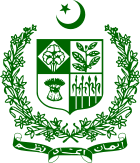- National Awami Party
-
Pakistan 
This article is part of the series:
Politics and government of
PakistanConstitutionPresidentJudiciaryAdministrative units
The National Awami Party (NAP) was a leftist political party in Pakistan. The party was founded in Dhaka in erstwhile East Pakistan in July 1957 through the merger of several leftist and progressive groups.[1] It advocated provincial autonomy, rights on the basis of ethnicity, recognition of ethinicities as 'nations' (as opposed to Islam as a nation) and a non-aligned foreign policy. It was the principal opposition party to the military regime for much of the late 1950s and mid 1960s. The party split in 1969 into two factions, the head of one faction remained in newly formed Bangladesh, while the remaining faction became the principal opposition party to the rule of Pakistan's Prime Minister Zulfiqar Ali Bhutto. The party was outlawed by the Pakistani government in 1975 and much of its leadership subsequently imprisoned for alleged anti-state activities.
Contents
Political ideology
The NAP set the following as its main aims:
1 Defence of the sovereignty, integrity and independence of Pakistan.
2 Non-aligned, independent foreign policy.
3 Ending of exploitation of Pakistan externally and its people internally.
4 Abolition of One Unit and reorganisation of provinces on linguistic basis.
5 Right of adult franchise.[2]In July 1965, as the manifesto was amended after the party's re-emergence, the NAP declared that the system of government in the country should be based on the concept of people's sovereignty. The Party advocated the maximum provincial autonomy in a confederal structure. Only Defence and Foreign Affairs were to be left with the 'Federal' government, while other powers were to rest with the autonomous units.[1] One-Unit in West Pakistan had to be replaced by a "regional confederation where provinces would be created on linguistic lines". In foreign affairs the Manifesto asked for non-alignment and withdrawal from the military pacts SEATO and CENTO.[3]
Party formation and history
The NAP was along with the Awami League expected to easily win the 1959 planned general elections. Its primary target was the disbanding of the One Unit scheme in West Pakistan and a fair deal for the increasingly discontented people of East Pakistan.[4]
After military dictator Ayub Khan, political parties were banned and the NAP faced a harsh crackdown from the Pro US Ayub Khan government. The NAP was regarded by some as a front organization of the Communist Party of Pakistan, Hasan Nasir, the NAP Office Secretary, a card-carrying member of the Communist Party, was tortured to death in custody. Mirza Mehdy Ispahani (a.k.a) Sadri Ispahani was the treasurer of National Awami Party.
Constituent parties
The constituent parties in 1957 and their areas of influence were:
- Azad Pakistan Party a party led by Mian Iftikharuddin,Syed Kaswar Gardezi and Mahmud Ali Kasuri.
- Sindh Mahaz led by G. M. Syed and Sheikh Abdul Majid Sindhi.
- Sindh Hari Committee led by Haider Bakhsh Jatoi.
- Wrore Pukhtun (Pukhtun Brotherhood) a Balochistan-based party led by Abdul Samad Khan Achakzai and Hashim Khan Ghilzai.
- Usthman Gul (Awam Jamaat) of Balochistan led by Ghaus Bakhsh Bizenjo, Gul Khan Nasir and Prince Karim Khan of Kalat (princely state).
- Khudai Khidmatgar from North-West Frontier Province led by Khan Abdul Ghaffar Khan and Hakeem Mohammad Aslam Sanjari.
- Ganatantri Dal an East Bengali party led by Haji Mohammad Danesh of Dinajpur and Mahmud Ali of Sylhet.
The party President was Maulana Bhashani and the Secretary General Mahmudul Huq Usmani. Afzal Bangash was the NAP's General Secretary in NWFP.
Party split
In 1958 and all political parties were banned. When Ayub allowed political parties again in 1962, the NAP was revived with all of its old components except the G.M. Sayed group and Ganatantri Dal.[5]
At the end of 1967 the NAP split between Bhashani and Wali Khan factions, After a growing rift developed over, allegedly, Maulana Bhashani allegedly told his supporters to support Ayub Khan in the 1964 elections against the joint opposition nominee Fatima Jinnah.[6] In return he was supposed to have received payoffs and favours, a fact which he never contradicted. After the council session of the party held at Rangpur on 30 November 1967, NAP split into two factions branding themselves as pro-Chinese and pro-Moscow groups. In 1967 NAP formally split into the pro-Chinese National Awami Party (Bhashani) and the pro-Soviet National Awami Party (Wali).,[1] while the peasant wing of the party in the NWFP, led by Afzal Bangash, formed a separate Mazdoor Kisan Party (MKP).
See also
- National Students Federation
- Awami National Party
- Khan Abdul Wali Khan
- National Awami Party (Wali)
- Sherbaz Khan Mazari
- Saifuddin Bohra
- Abdul Hai Baloch
- Jam Saqi
- Baloch Students Organization
References
- ^ a b c The National Awami Party of Pakistan: Leftist Politics in Crisis M. Rashiduzzaman Pacific Affairs, Vol. 43, No. 3 (Autumn, 1970), pp. 394-409 Published by: Pacific Affairs, University of British Columbia
- ^ Balochistan Nationalism and its origins
- ^ National Awami Party (NAP), The Manifesto of National Awami Party of Pakistan. Karachi: Anjuman Press, nd, p. 5.
- ^ National Awami Party Last accessed on 30 December 2009
- ^ Progressive Movements in Pakistan collection
- ^ National Awami Party
External links
Categories:- Communist parties in Pakistan
- Communist parties in Bangladesh
- Political parties in Bangladesh
- Political parties in Pakistan
- Political parties established in 1957
- Defunct political parties in Pakistan
Wikimedia Foundation. 2010.
